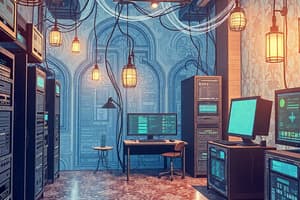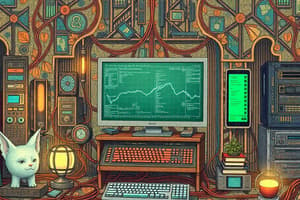Podcast
Questions and Answers
What is an Information System (IS)?
What is an Information System (IS)?
A set of interrelated components that collect, process, store, and disseminate data and information; it includes a feedback mechanism to monitor and control its operation to ensure it meets goals and objectives.
Which of the following is NOT one of the six core components of a Computer Based Information System (CBIS)?
Which of the following is NOT one of the six core components of a Computer Based Information System (CBIS)?
- Procedures
- People
- Hardware
- Marketing (correct)
- Databases
- Software
List three examples of computer hardware technologies used in information systems.
List three examples of computer hardware technologies used in information systems.
Any three from: Dell Inspiron desktop computer, Sony LCD Flat Panel Monitor, Dell PowerEdge 2600 File Server, iPhone, USB Barcode Scanner, RFID Chip, Wifi access point, Networks cables.
List three examples of computer software technology.
List three examples of computer software technology.
What are the two main categories of Information Systems presented in the hierarchy?
What are the two main categories of Information Systems presented in the hierarchy?
Which type of information system primarily processes business transactions?
Which type of information system primarily processes business transactions?
Which system monitors and controls industrial or manufacturing processes?
Which system monitors and controls industrial or manufacturing processes?
What is the main purpose of an Enterprise Collaboration System (ECS)?
What is the main purpose of an Enterprise Collaboration System (ECS)?
Which system provides prespecified reports and summary tools for managers?
Which system provides prespecified reports and summary tools for managers?
Which system type is characterized by features like What-if Analysis, Decision Modeling, and Scenario Building?
Which system type is characterized by features like What-if Analysis, Decision Modeling, and Scenario Building?
What is the main function of an Executive Information System (EIS)?
What is the main function of an Executive Information System (EIS)?
Tactical decision-making focuses on doing things the right way (_____ term), while strategic decision-making focuses on doing the right things (_____ term).
Tactical decision-making focuses on doing things the right way (_____ term), while strategic decision-making focuses on doing the right things (_____ term).
Information systems are increasingly being used only at the operational level, not the strategic level.
Information systems are increasingly being used only at the operational level, not the strategic level.
According to the presentation, who represents the 'People Technology' component of an Information System?
According to the presentation, who represents the 'People Technology' component of an Information System?
Which of the following best describes the role of 'Procedures' in an Information System?
Which of the following best describes the role of 'Procedures' in an Information System?
Match the information system level with its primary support function.
Match the information system level with its primary support function.
Flashcards
Information System (IS)
Information System (IS)
A set of interrelated components that work together to collect, process, store, and disseminate data and information, while also providing a feedback mechanism to monitor and control its operation to ensure that it continues to meet its goals and objectives.
Computer Based Information System (CBIS)
Computer Based Information System (CBIS)
An organized set of inter-related components including: hardware, software, communications networks, databases, people, and procedures.
Hardware
Hardware
Physical components like computers, monitors, and network cables.
Software
Software
Signup and view all the flashcards
Communications Networks
Communications Networks
Signup and view all the flashcards
Databases
Databases
Signup and view all the flashcards
People in IS
People in IS
Signup and view all the flashcards
Procedures in IS
Procedures in IS
Signup and view all the flashcards
Strategic Level Information Systems
Strategic Level Information Systems
Signup and view all the flashcards
Business Decision Making Information Systems
Business Decision Making Information Systems
Signup and view all the flashcards
Business Process and Operations Information Systems
Business Process and Operations Information Systems
Signup and view all the flashcards
Advantage of Information Systems
Advantage of Information Systems
Signup and view all the flashcards
Transaction Processing System (TPS)
Transaction Processing System (TPS)
Signup and view all the flashcards
Process Control Systems (PCS)
Process Control Systems (PCS)
Signup and view all the flashcards
Enterprise Collaboration Systems (ECS)
Enterprise Collaboration Systems (ECS)
Signup and view all the flashcards
Management Information System (MIS)
Management Information System (MIS)
Signup and view all the flashcards
Decision Support System (DSS)
Decision Support System (DSS)
Signup and view all the flashcards
Executive Information Systems (EIS)
Executive Information Systems (EIS)
Signup and view all the flashcards
Information Flow
Information Flow
Signup and view all the flashcards
Study Notes
Information Systems
- Information systems consist of interrelated components for collecting, processing, storing, and disseminating data and information.
- Information systems provide a feedback mechanism to monitor and control operations so goals and objectives are met.
Computer-Based Information System (CBIS) Components
- Hardware
- Software
- Communications networks
- Databases
- People
- Procedures
Computer Hardware Technologies
- Dell Inspiron desktop computer
- Sony LCD Flat Panel Monitor
- Dell PowerEdge 2600 File Server
- iPhone
- USB Barcode Scanner
- RFID Chip
- WiFi access point
- Network cables
Computer Software Technology
- Windows 10
- Graphics Card Driver Software
- PowerPoint
- SQL Server database management system
- CRM software
- SCM platform
- Sage Accounting
- E-commerce website
Telecommunications Network Technologies
- Ethernet
- Netgear Wireless Router
- Cable Modem
- Cell Phone
- WiFi, WiMax card
- Bluetooth device
Data Resource Management Technologies
- IBM DB2 8.2
- Microsoft SQL Server 2000
- Oracle Database 10g
- MySQL
- Data Mining Software
- MS Access
People Technology: An IS Component
- End users
- Data entry personnel
- Managers
- Programmers
- Database administrators
- Cashiers
- Secretaries
- Professors
IS Related Procedures
- Processes for data collecting
- Processes for data access
- Processes related to data management
- Processes related to data storage and destruction
Information Systems Roles
- Information systems can support three different levels in business:
- Support strategies for competitive advantage
- Support business decision making
- Support business processes and operations
Expanding Role of IS
- Information Systems are being used in more areas, especially at the strategic level.
- IS expands the participation of end users.
- Information flows up the pyramid faster and more effectively.
Types of Information Systems
- Transaction Processing Systems (TPS)
- Process Control Systems (PCS)
- Enterprise Collaboration Systems (ECS)
- Management Information Systems (MIS)
- Decision Support Systems (DSS)
- Executive Information Systems (EIS)
Transaction Processing System (TPS)
- Supports operations and updates operational databases.
- ATM machines handle banking transactions.
- Cash register systems handle point of sale transactions.
- Accounting systems handle checking account transactions.
- Pay-per-view or OnDemand is a TPS.
Process Control Systems (PCS)
- Supports operations and monitors/controls industrial/manufacturing processes.
- Used in petroleum refining, power generation, and automobile manufacturing.
Enterprise Collaboration Systems (ECS)
- Supports operations, teamwork, communication, and collaboration.
- Chat
- Video Conferencing
- Calendaring
- Journaling
- Workflow
- File Sharing (Google drive, Morpheus, Limework)
Management Information System (MIS)
- Supports management analysis and reporting.
- Charts, graphs, and summary tools are used.
- Moodle is used for managing college information.
- Spreadsheets (like Excel) are one of the first and most basic.
- Oracle's Corporate Performance Management is another example.
Decision Support System (DSS)
- Supports management through what-if analysis, decision modeling, and scenario building.
- Highly interactive and ad hoc.
- Enterprise Decision Manager 2.0 and AIMMS 3.6 are examples.
- Most DSS's are custom developed for specific companies.
Executive Information Systems (EIS)
- Supports high-level strategic management.
- EIS provides critical information from other systems (MIS and DSS).
- Portal concept provides one place with links to all information.
- EIS's integrate external information such as economic developments and news about related markets and competitors.
- Strategic decision making is aided.
- Tactical involves doing things the right way right (short term).
- Strategic involves doing the right things (long term).
Studying That Suits You
Use AI to generate personalized quizzes and flashcards to suit your learning preferences.




